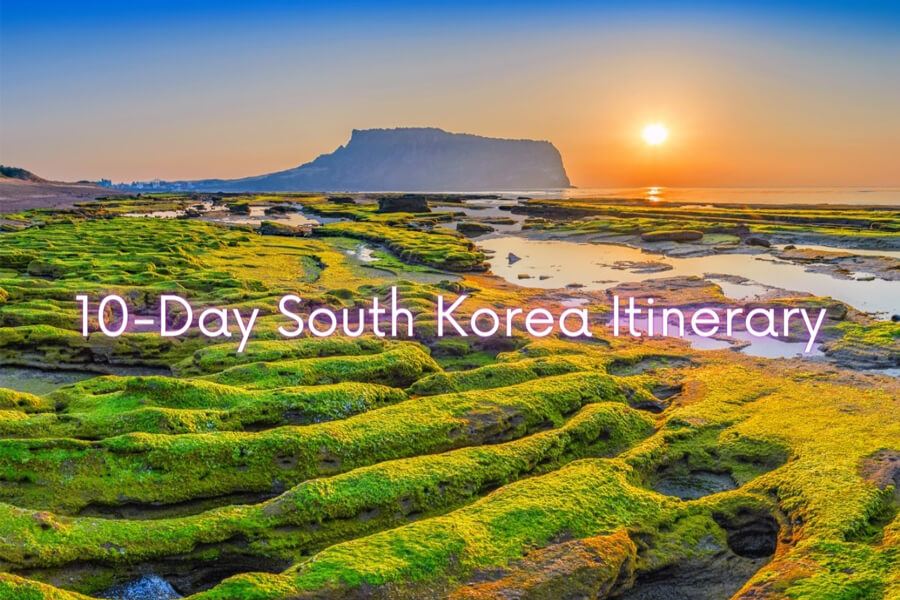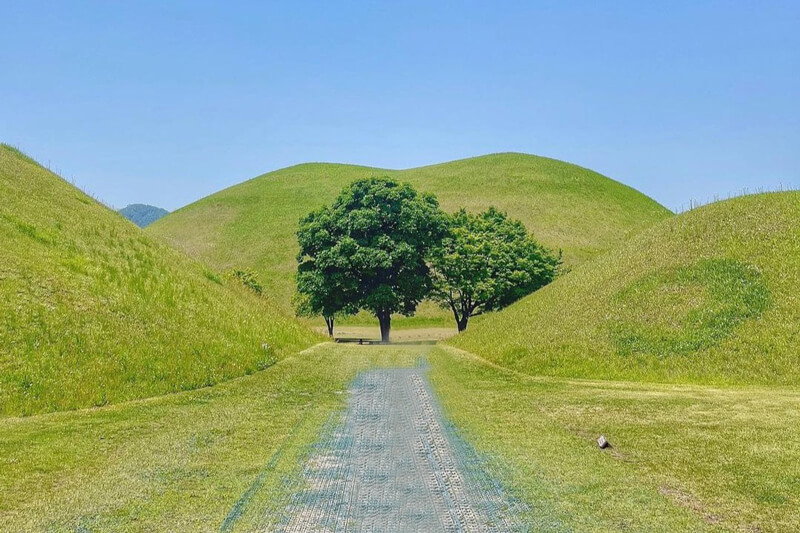If you’re looking for a travel destination that offers a rich cultural experience and a glimpse into history, South Korea is the perfect choice. Despite its small size, this country is packed with diverse attractions and a unique charm that will captivate any traveler.
Whether you’re interested in exploring ancient palaces, indulging in delicious street food, or immersing yourself in the vibrant K-pop culture, South Korea has something for everyone. With this ultimate 10-day South Korea itinerary, you’ll be able to make the most of your time in this fascinating country.
South Korea will give you the perfect opportunity to create a storming itinerary to explore the bustling cities quiet mountains and countryside. South Korea has a synchronized harmony of traditional culture and modern history.
Tourists can enjoy the cultural heritage through the UNESCO sites and can enjoy the variety of food, local culture, and lifestyles. Along with Korea’s Buddhist temples, and UNESCO sites you will find beautiful mountains, hiking trails, and port cities will let you experience the full range of diversity in the country.
Planning a Trip to Korea Preparations

Planning a trip to Korea involves a lot of steps, especially when you have a 10-day itinerary in mind. Here are some details to make your preparation easier:
Visa or ETA: First, check if you need a visa or an Electronic Travel Authorization (ETA) to enter Korea. If you require a visa, you can refer to my visa application guidelines for assistance.
Weather Considerations: Understand the weather conditions during your visit to Korea. Pack your clothes, accordingly, considering the weather or season prevalent during your travel dates.
Flight Booking: Start looking for flights as early as possible. Flight tickets tend to be more expensive if purchased just before your travel dates. Aim to purchase tickets a few months in advance to get the best prices. You can use flight search engines like trip.com or set up alerts on Google Flights for deals.
Travel Insurance: Consider getting travel insurance. It can be immensely helpful in case of flight delays or baggage losses, providing you with financial protection and peace of mind during your trip.
To have a hassle-free trip to South Korea there are few more things you can do to prepare. Few of them are using a language translator app, using specialized local maps, downloading cab app, and getting cashless money transfer systems. Here are the top apps for planning South Korea itinerary 10-days you can use to make your journey easy.
By following these steps and tips, you can streamline your trip planning process and ensure a smoother travel experience to Korea.
10-Day South Korea Itinerary:
Starting your 10-day adventure in Korea by arriving at Incheon, Seoul is a fantastic choice. Incheon Airport is well-connected globally, making it convenient for travelers. Once you’re in Seoul, you’ll dive into the captivating royal history and indulge in the delicious world of Korean cuisine. With so much to see and do, Seoul can easily fill your entire itinerary. However, if you’re landing in Busan or another city first, feel free to customize your schedule accordingly. Flexibility is key to ensuring you make the most of your Korean journey!
Day 1 to 2 in Seoul: 2 Days

Seoul offering a modern yet traditional lifestyle should be the first place in your south Korea itinerary for 10-days. The Seoul trip for two days will be your first step in familiarizing yourself with the city’s cultural, historical, and traditional sides. Take the first day slow and visit the royal palaces and UNESCO sites. You can start your trip with Gyeongbokgung Palace, and then continue to visit Cheonggyecheon Stream, Gwangju Traditional Market, and Insadong Shopping Street.
Gyeongbokgung is one of the most popular and oldest palaces in Seoul. This served as the main official palace during the Joseon dynasty. The entrance fee to the palace is $2.50 and you can also rent hanboks if you want great pictures in the traditional dresses. After the tour head over to the Cheonggyecheon Stream where you can enjoy a nice walk and enjoy the art murals, greenery, and scenic beauty.
Make your way to Gwangju Market, where you will be enjoying a whole array of foods. Some of the famous foods there as one of the oldest markets in Seoul are bindaetteok, mandu-guk, and bibimbap. From there you can go to visit the traditional Bunchon Hanok village.
For Day 2 in Seoul, start your day with a delicious breakfast in Hongdae. Hongdae is a vibrant area where young people hang out and Hongdae shopping street is also a great area to hang out. From there you can go to museums of the city and during the sunset hike up the N Seoul tower where you will enjoy the beautiful city’s nighttime landscape view. You can also have an amazing dinner on the restaurants of N Seoul tower.
Other places that you can visit in Seoul
Changdeokgung Palace:
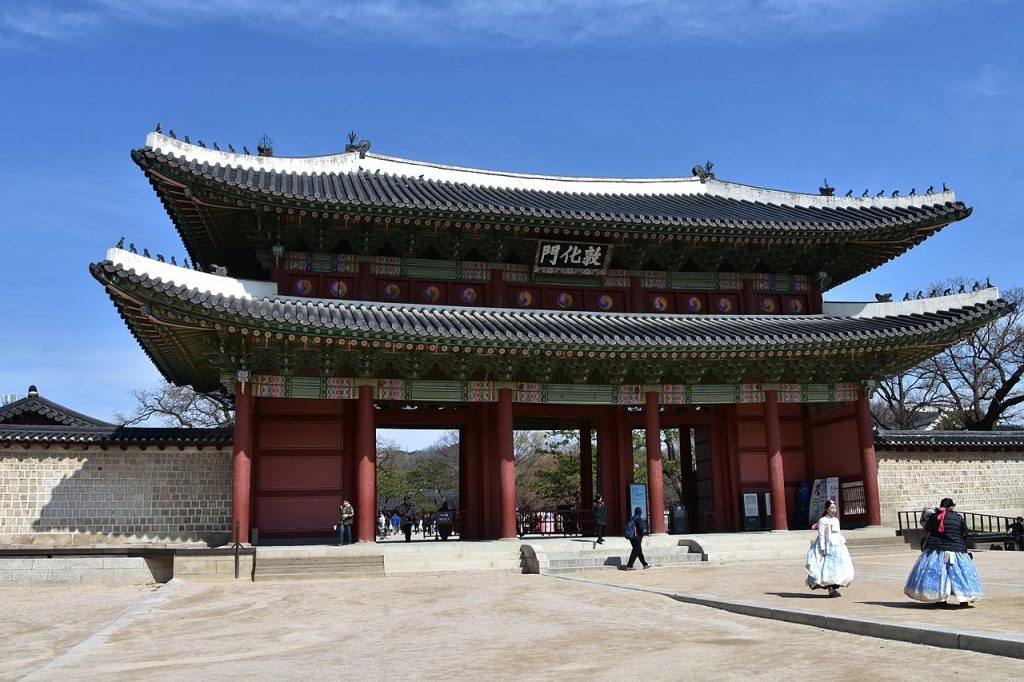
One of the most popular UNESCO sites in Seoul is the Changdeokgung Palace. Changdeokng Palace is an official residential building built in the Joseon dynasty. This complex was built as a secondary palace from Gyeongbokgung Palace to have the administrative work done.
Gyeongbokgung Palace:
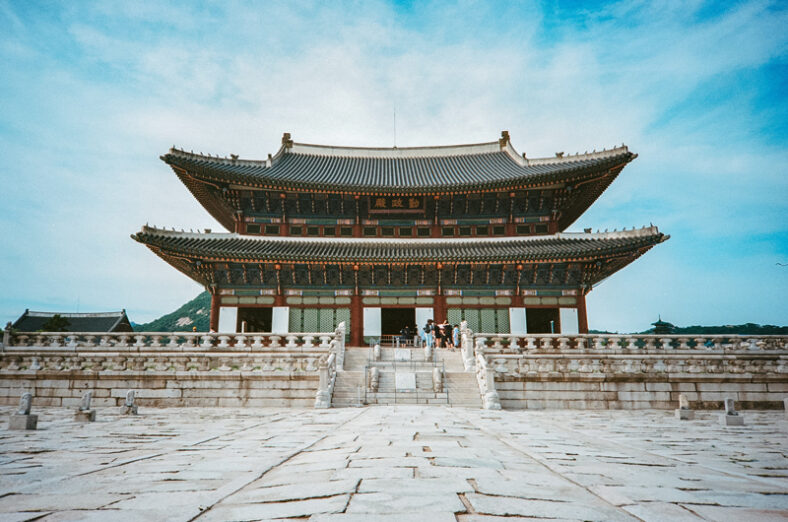
The Gyeongbokgung palace is a South Korean first palaces for administrative work. It was built in 1935 in Hanyang, currently the heart of Seoul. This is quite famous for taking pictures in hanbok, traditional korean dress and visiting the historical settings, and artefacts. At the entrance, you will also find the historical Gwanghwamun gate located at the three-way intersection.
Namsan Tower:
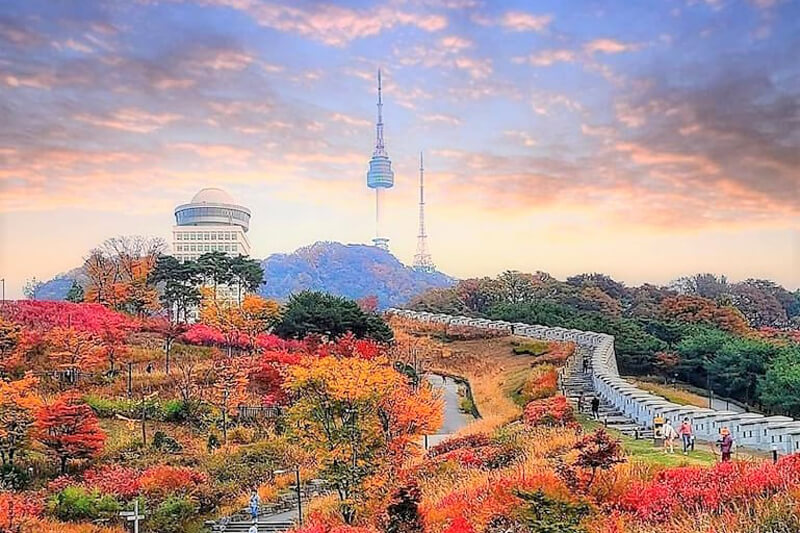
Namsan tower located in Seoul is an observatory tower on the highest hill in Yongsan-gu district of Seoul. It gives undeniably the best view in the city and is worth a visit. The lovelocks there for couples are also quite famous. You can also enjoy the views from the cafe or the restaurant on the N Seoul tower.
Lotte World:

Lotte World is a major theme park in Seoul with indoor and outdoor rides, shows and parades, and an aquarium. If you have come here with children, taking a day to go to Lotte world will really make the trip a lot of fun. The aquariums, ice rink and parades are a true treat to kids.
Nami Island:

Nami Island has gained popularity as a scenic and romantic spot, and you can go there to enjoy cherry blossoms and the tree-lined pathways are quite romantic during Autumn and Spring. You can also enjoy different types of activities like cycling, zip lining and boating in Han River.
Day 3: Trip to DMZ
The DMZ tour from Seoul takes a whole day. You must keep aside a one-full day for this historic area. You can only have guided tours of the DMZ area. The Demilitarized Zone portrays the rich history of the Korean Wars. The DMZ tour packages are available from $25. Visit the freedom bridge, DMZ exhibition hall, and other monuments. You will get a brief recap of the historical moments throughout the trip to DMZ.
Day 4 & Day 5: 2 Days in Andong
By Korean standards, it’s a long journey between Seoul and Gyeongju. For this itinerary, there’s no better place to break up the trip than Andong. Long known for its traditionalism, Andong is a center of culture and folklore. It’s one of the best places to visit in South Korea for a glimpse of its ancient past.
For Day 1: Explore the impressive grounds of the historic Neo-Confucian Academy with a trip to the historic Dosan Seowon and for Day 2: Admire a stunning view of the surrounding natural landscapes from the top of the Buyongdae Observatory.
Also, the Woryeonggyo Bridge, a wooden footbridge crossing the Nakdong River, provides breathtaking views of the surrounding mountains and is a popular spot for photographers and nature enthusiasts.
Day 6: 1 Day in Gyeongju
No place during your 10 days in South Korea will live up to expectation better than Gyeongju. This fascinating city is nothing short of the cultural and spiritual heart of Korea. Gyeongju checks off all the boxes that drove you to visit South Korea in the first place.
Compared to the hubbub of Seoul and brash Busan, Gyeongju is a relaxing respite. And it’s as fulfilling as either. The top attractions in Gyeongju are spread far & wide. They encompass some of Korea’s finest cultural moments. Tumuli Park is one of the few Gyeongju tourist attractions smack dabs in the middle of town. The park is an ancient burial site. About two dozen Korean royal tombs sprout from the earth here.
Day 7 & Day 8: 2 Days in Jeju Do
Jeju is South Korea’s one of the most vibrant islands to experience beautiful braces, local markets, and more. On the first day arriving in Jeju, you can visit the Jeju Folklore and Natural Music and Halla Arboretum. And you can then visit the Jeju five-day folk market and Dongmun Traditional Market.
The next day you can catch the sunrise at Hallasan or at Sarabong Peak early in the morning. Then you can go visit the Hamdeok beach and Manjangul cave. There are a lot of places to explore in the south of Jeju-do and you will have a refreshing experience while travelling here.
Day 9: Busan
Busan is one of those take-it-or-leave-it places. Apparently, suggests that anyone should fall in love with, or even like, this brash Korean port city. And that’s usually where the story ends. When you are in Busan, don’t leave out the bustling Jagalchi Fish Market.
It’s one of the city’s top cultural attractions, and an absolute must-see and must-do. This is not just the port city’s most significant market; it’s the biggest fish market in South Korea. All types of seafood caught around the Korean peninsula find their way to the market stalls of Jagalchi Fish Market.
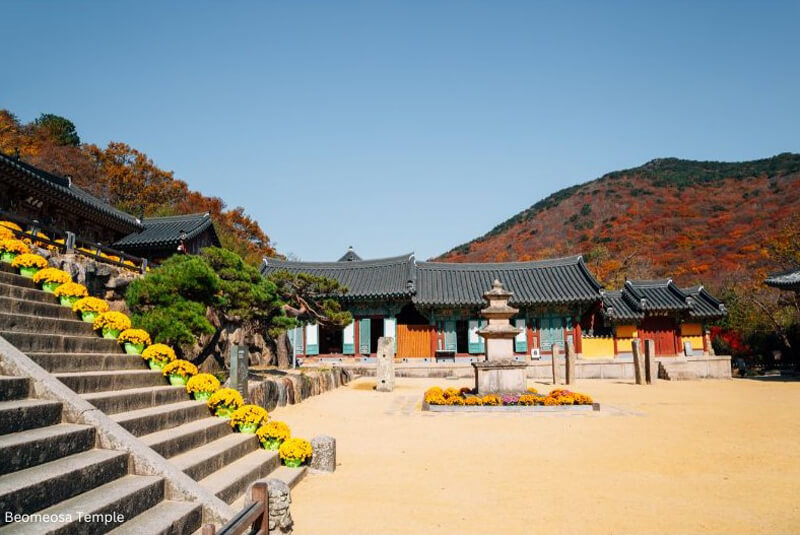
With your trip coming to close soon, make time to fit one more temple into your Korea itinerary: Beomeosa Temple. This ancient temple is Busan’s top tourist attraction. The original temple was founded in AD 678 by Ui Sang, a monk in the Jogye Order of Korean Buddhism. It has since been rebuilt multiple times. Most of the current buildings hail from the 16th and 17th centuries.
From stone pagodas to ornate wooden gates, the beauty of the city entrances you. The temple also benefits from a spectacular location. It sits at the foot of Mount Geumjeongsan. Visiting Beomeosa Temple, it’s easy to forget you’re in Korea’s second-biggest city.
Day 10: Departure
On Day 10, you can either return to Seoul or fly back home from Busan. Make sure to pack your things. The last day is perfect for some last-minute shopping or enjoying a final meal with friends or family. If you have extra time, you can also visit a few more places of your choice.
Most Popular Tourist Attractions in South Korea
There are a lot of beautiful places across South Korea where you can experience a diversity of landscapes, culture and food. Taking a trip to South Korea is a phenomenal way to experience the joys of life. Here are the top few tourist attractions and landmarks of South Korea that any first-time traveler must cover. Also, you may read Places to visit in Korea here.
DMZ:
DMZ is a zone between South Korea and North Korea near the 38th parallel north. And the demilitarized zone is a walk through the history for tourists where you can understand the value of the war history of the country. This area works as a buffer zone between two countries and is a place for maintaining political peace.
Hwaseong Fortress:
Hwaseong fortress is a one-of-a-kind brick and pilestone fortress made in Joseon dynasty. It’s located in the centre of Suwon, a few kms away from Seoul. It was built by King Jeongjo to honour his father, Prince Sado.
Jeju Island:
Jeju Island is one of the most peaceful and pleasant natural spaces that you can visit. It is one of the most beautiful volcanic islands on the planet Earth. Top attractions in Jeju-do are the lava tunnels, Hallasan, Cheonjiyon waterfall, and the hiking trails.
Traditional Villages:
There are a beautiful Korean village like Bukchon Hanok, Yongin-si in Seoul where you can get roam around the beautiful streets, visit artisans and traditional arts.If you travel to Andong during your trip, you must visit Andong folk village to visit the Andong folk museum, thatched house. You can also visit the Jeonju-si for old shrines, Boseon-gun in South Jeolla province for the entrancing beauty.
Dodohaehaesang National Park:
Dodohaehaesang National Park is the largest natural park in South Korea and if you are a nature lover you will have a great time as there are 1500+ plant species and 1200+ animal species. The scenic beauty of the island the park is located on is all the is also an attraction.
National Museum of Korea:
National Museum of Korea has collections of Korean traditional products, and you will find a lot of art exhibitions going on every day worth visiting. You will see the collection of art, artifacts, and crafts from Korean and international artists at the National Museum.
South Korea Food Markets
South Korea has a lot of vibrant food markets which are worth visiting for tasting local foods and get immersed in the local lifestyle. A few of the top South Korean food markets are Gwangjang Market, Namdaemun, and Dongdaemun Design Plaza in Seoul for tasting the most famous traditional foods. You may also visit the jagalchi fish market in Busan for fresh fish and seafood and tasty foods.
Budget for South Korea 10-Day Itinerary
Your travel tastes, style, and the time of year you intend to travel all affect how much money you allocate for a 10-day itinerary in South Korea. I can give you a general idea of the expenditures related to a traveler on a medium budget, though. Please be aware that these projections were created using pricing as of my January 2024 update and may have altered since then.
Flight: Cost: $700 – $1,200 (depending on origin and time of booking)
- Best Deals: Malaysia, Singapore, and the Philippines often have the best cheaper tickets.
- Example: I got a round-trip ticket from Kuala Lumpur to Seoul for around $150.
Accommodation: The price of lodging can change based on the area and the type of lodging you select (hotels, hostels, guesthouses, etc.). Budget travelers should budget $70 to $100 per night for a mid-range hotel or guesthouse, on average.
Food: South Korea offers a wide variety of food options to fit any budget. For about $10 to $15 per meal, budget-conscious travelers can enjoy delicious street food and local dishes. If you prefer dining at mid-range restaurants, expect to spend between $15 and $30 per meal.
Transportation: South Korea has a great public transit system, including buses and subways. For ten days, plan to spend around $100 to $150 on transportation within cities and for traveling to different locations. The KTX train from Seoul to Busan costs $60 to $80 one way, or $120 to $160 for a round trip.
Activities and Sightseeing: Different attractions and activities have different entrance prices. Budget, on average, $5 to $20 per attraction. You can budget between $100 and $150 for this category if you’re going to numerous paid attractions.
Shopping and souvenirs: Depending on your shopping tastes, this expenditure can vary greatly. Budget travelers should set up $100 to $200 for shopping and souvenirs.
Miscellaneous: It’s smart to keep some extra cash for unexpected expenses like tips, extra snacks or drinks, or emergencies. Set aside $100 to $200 for these additional costs. Also, plan to spend $50 to $100 on travel insurance.
Without including international flights to and from South Korea, a rough estimate for a 10-day moderately priced vacation in South Korea is between $800 and $1,000. Keep in mind that this is just an estimate, and the actual cost may vary based on your choices. It’s a good idea to research prices and expenses for your specific route and travel dates to get a more accurate budget. Happy planning and enjoy your trip to South Korea!

